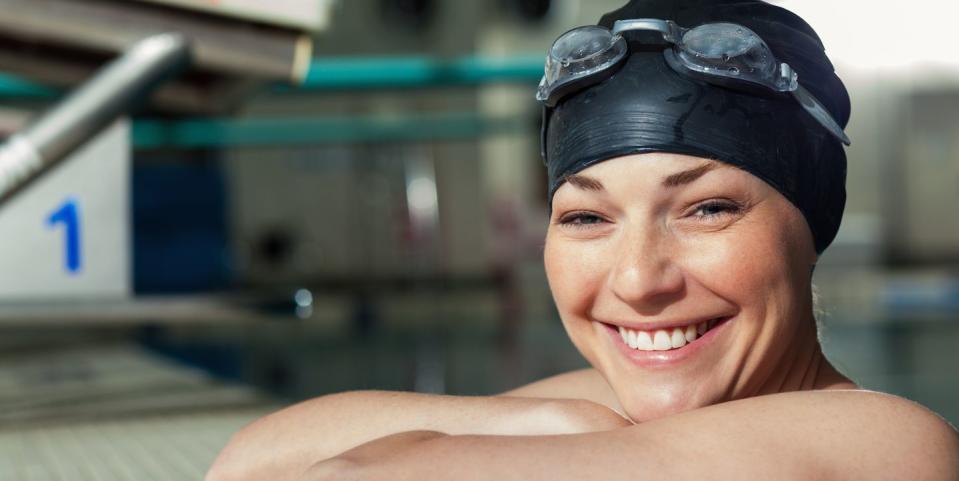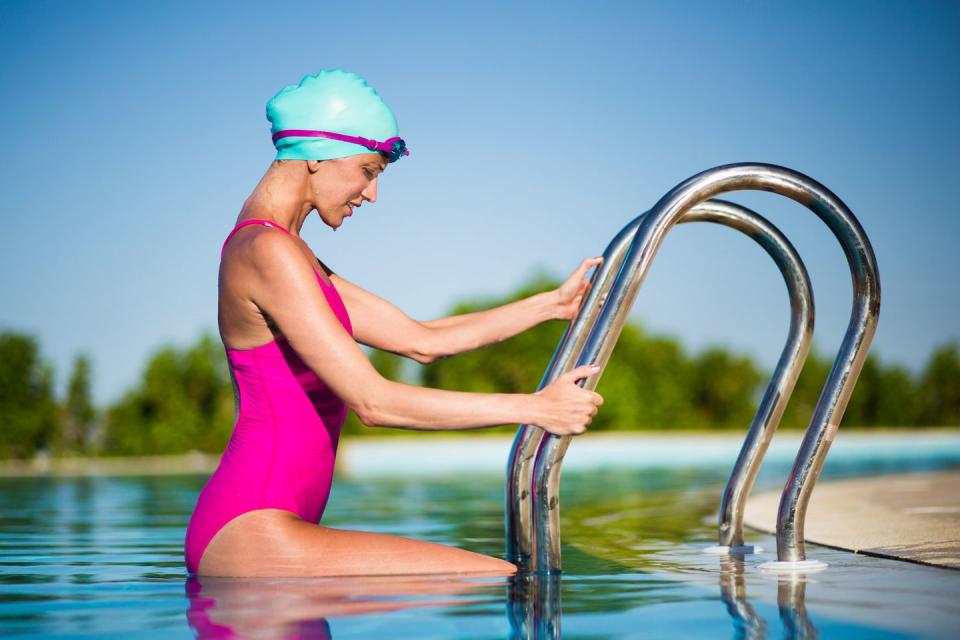Swimming tips for adult beginners: how to get started

The reasons to learn to swim are many and varied, from simply being a fun pastime to providing rigorous and effective exercise. But according to research carried out by the Amateur Swimming Association (ASA) around one in five adults don't know how to swim. Whether you're learning for the first time or simply want to improve your in-water abilities, take comfort in the fact that you aren't alone.
We speak to Alyson Zell, aquatic business manager at Freedom Leisure, about how to learn to swim (or refresh your skills) for adults:
Is it too late to learn to swim?
While adults aren't nearly as carefree as children when faced with the prospect of swimming for the first time, it's never too late to learn and swimming can benefit your life in a myriad of ways irrespective of your age.
'When adults decide to learn to swim it is usually for a good reason – before a holiday, so they can join their children who can swim, or they want to participate in an activity where they need to be able to swim, such as sailing,' explains Zell.
'This means they are more likely to succeed. Everyone can learn to swim, it is just the journey that is different. If you cannot swim you are missing out on a great way to keep fit and healthy.'
The benefits of learning to swim
Apart from making you look great physically, swimming will also make you feel great mentally. Just 30 minutes of pool time three times a week improves sleep patterns, lowers stress levels and significantly reduces the chances of anxiety and depression.
Swimming also builds endurance, muscle strength and cardiovascular fitness, while helping maintain a healthy weight, a healthy heart and happy lungs.
So, it's time to grab your goggles and (literally) dive in at the deep end! Before you go, though, we've put some tips together to ensure you get the most out of your sessions in the pool:

Before you get to the pool
Staying calm in the water is essential, so aim to build water confidence in the bathroom before progressing to the pool.
'The more relaxed you are the easier it will be to learn,' says Zell. 'Easier said than done I realise, but try practicing submerging your face while gently breathing out as this is an important skill for swimming. You can easily do this at home in the bath, shower or sink while your feet are on dry land.'
Practise breathing techniques
Because breathing is such an important part of swimming, make sure you can master it in advance of hitting the deep end. Get used to the idea of keeping your breathing steady and controlled while your body's main focus is on something else.
Try controlled breathing during running, walking, or even something as simple as doing the ironing or cooking dinner. Your swim teacher will teach you breathing techniques to stay calm and enjoy being in the water.
Get the right swim gear
Investing in the right gear will benefit your swimming and make the entire process more enjoyable. 'Make sure you choose suitable swimwear that will not impede movement, and long hair needs to be tied up or use a swim hat,' suggests Zell. 'Goggles can also be useful to assist the learner to submerge.'
There are also a few other not-so-well-known accessories out there that you might find useful on your road to swimming success.
Nose clips and earplugs can prevent you from getting water in unwanted places and causing discomfort. They can also help protect you from developing sinus problems and ear infections – two things that would stop you from being able to swim, and nobody wants that!
Kickboards and hand paddles are also good aids for helping you build strength in your arms and legs, as well as doubling as floatation aids while you're still getting to grips with the whole process. Don't go buying these before your lessons if you have an instructor as they will most likely provide them or advise you what to buy for yourself.
Put swim practice time in
Swimming is one of those sports where it really pays to work on technique. No matter how many lengths you're doing a day, your body won't reap the benefits unless you've mastered the basics. Doggy paddle might be easy, but it doesn't exactly scream elegance and efficiency. To take your first steps towards building style and speed, Zell stresses the benefits of streamlining.
'Position in the water is crucial to produce the correct body position to minimise resistance and assist buoyancy,' says Zell. 'Try to practice gliding by using floats, buoyancy aids or partner support and learn how to regain standing position. It is important to learn how to stop once you get started.'

Perfect your technique
Decide on what stroke works best for you and then strive to perfect it.
'There is no right or wrong stroke to start with it will depend on the learner's natural ability,' says Zell. 'Often adult learners can have difficulty with an up and down flutter kick so may prefer a breast stroke leg action.'
Front crawl swimming tips
If it's the front crawl (also referred to as freestyle) you're working on, keep your stomach flat, head in line with your body and eyes looking forward and down.
Your hands should enter the water palm first on each individual stroke, and make sure you keep your fingers closed to improve speed.
Move your arms up and over your head one at a time in a propelling motion before bringing them back towards your body, imitating an hour-glass shape.
Breaststroke swimming tips
For breaststroke, your legs and arms should be moving simultaneously in a strong and stable rhythm.
As your hands stretch out in front of you and then back towards your chest, your head should rise so that the chin rests on the surface of the water.
Bring your legs up towards your bottom with your feet turned out before kicking back down to propel you in a frog-like motion.
Rest and rehydrate between sets
Like any sport, swimming can get tiring. Water is almost 800 times more dense than air, so it's not surprising if you find yourself feeling worn out quicker than you do when completing other forms of exercise.
Because of this, make sure you know how to regain strength while in the water. Zell suggests floating as a good thing to do for some time-out. 'Floating on the back is easiest to master using a star position as you can keep your face clear of the water,' she says. 'This is great safety move if you get tired or out of your depth.'
While surrounded by water, having a drink might seem like a weird thing to do. However, as with any activity, your body will still need to hydrate, so make sure you have a water bottle by the side of the pool to quench your thirst and help you keep going for longer.
Don't forget to cool down
When you're working hard in the pool on faster strokes or with a kickboard, your muscles will be getting a pretty intense workout, especially if you haven't done much swimming before. 'Cooling down' might seem like an odd suggestion seeing as the water will stop you from feeling too hot, but it's worth warming-down with some gentler exercise at the end of each session in order to prevent injury.
Last updated: 20-02-2020
You Might Also Like

